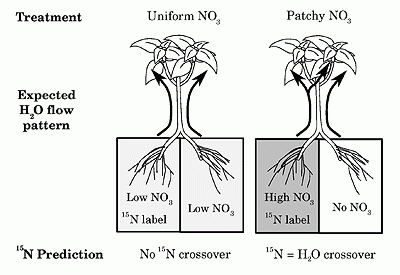Past Research
Plant Responses to Environmental Heterogeneity
Project Leaders: Alexandra Thorn and Colin Orians
The resources required for plant growth are often patchily distributed. Our work examines how the vascular architecture of plants constrains their responses to patchy resource availability. We have shown that certain ecological conditions tend to maximize the ability of plants to exploit patchiness in their immediate environment and as importantly that species differ in their ability to exploit patchy resources.
Brief background: Many view plants as being integrated -- capable of translocating resources from one part of the plant to all other parts. In reality, many vascular plants are sectorial -- exhibit restricted movement of nutrients, photosynthate and signal molecules along specific vascular, xylem or phloem, pathways. Sectoriality can affect the patterns of "systemic" induction by constraining the transport of signal molecules, and may affect plant growth, chemistry, and physiology by restricting the movement of nutrients from roots to shoots. We are exploring how differences among species affect their responses to soil nutrient heterogeneity, localized herbivory, and tolerance to drought.

Exotic Herbivores on a Native Tree
Project Leaders: Colin Orians, Evan Preisser and Carol Thornber
The invasive Hemlock Woolly Adelgid (Adelges tsugae), accidentally introduced from Japan in the 50’s, is causing widespread and rapid decline of Eastern Hemlock (Tsuga canadensis) in North America. Despite fears that the hemlock woolly adelgid would eliminate hemlocks from southern New England, mortality in this area is occurring much more slowly than predicted.
It has been hypothesized that the interaction with another exotic insect, the Elongate Hemlock Scale (Fiorinia externa), might be the cause for this reduced mortality. Possible mechanisms behind this interaction may include inter-specific competition for resources and/or induced responses. We are trying to understand the basis for this variation and focusing on the nutritional, defense-related, morphological and biomechanical changes that might explain differential mortality.
We found that prior attack by one insect impacts plant chemistry, insect behavior and ultimately plant resistance.